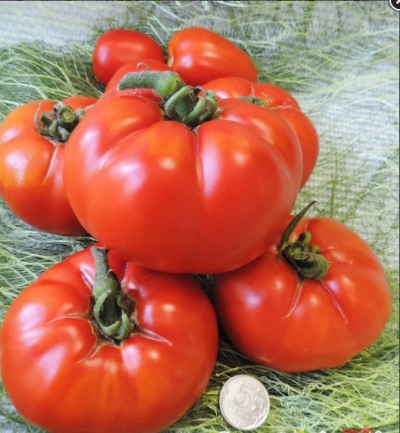
- Authors: Vasilevsky V. A., Nalizhity V. M., Korotkov S. A., Dynnik A. V. (JSC Scientific and Production Corporation "NK. LTD")
- Year of approval: 2000
- Category: grade
- Growth type: indeterminate
- Appointment: fresh consumption
- Ripening period: late ripening
- Ripening time, days: 115-120
- Growing conditions: for open ground, for film greenhouses, for greenhouses
- Marketability: high
- Bush height, cm: 100-180
The Giant tomato variety is most suitable for planting and growing in the southern regions. Most often it is used for fresh consumption. It should be noted that this variety boasts a special disease resistance, excellent presentation. The crop can, if necessary, be stored for a long time after harvesting at home, the fruits will not deteriorate and rot.
Description of the variety
The giant is an indeterminate powerful plant. The bushes have medium-sized leaves with a rich green color. Inflorescence in a culture of intermediate type. The total height of each bush is approximately 100-180 centimeters.
Growing bushes thrive and bear fruit in areas that are well lit by sunlight, where there is sufficient heat. And also such a culture should be well protected from the cold wind currents.
The main qualities of the fruit
Ripe tomatoes of this variety have a bright red color. They can be medium to large in size. The ripe fruit has a flat-round shape. Each vegetable weighs about 90 grams, but there are also large specimens weighing up to 300 grams.
The flesh of the fruit is rather fleshy and low-seeded. The skin of these vegetables is smooth.
Taste characteristics
The Giant variety has excellent taste. More often ripe tomatoes are used for fresh consumption, but sometimes they are also taken for making sauces, salads and other dishes.
Ripening and fruiting
This species belongs to the late-ripening ones. Ripening dates are approximately 115-120 days after planting. The harvest dates are from July to August.
Yield
The Giant variety is a high-yielding variety. From 1 square meter of territory, you can collect from 5.9 to 6.2 kilograms of ripe tomatoes.
The timing of planting seedlings and planting in the ground
Sowing seedlings is best done in late winter or early spring. Planting in a permanent place in open soil should be done in May-June.

Growing tomato seedlings is an extremely important process, because it largely depends on whether the gardener can harvest at all. All aspects must be taken into account, from seedbed preparation to planting in the ground.
Landing scheme
First, you need to prepare the required number of containers for planting seedlings. You can use simple disposable plastic cups.
And you will also need to prepare the ground for this. Mix the soil with a little peat; other nutrients can be used.
All containers are filled with earth. After that, small grooves are formed there, and seeds are poured into them, deepening a little inward. All this is sprinkled with soil a little.
After that, all containers with seeds are sent to storage at temperatures above room temperature. Two-month-old seedlings are transplanted into open ground. To do this, it is necessary to form the landing holes in advance. At the same time, it is also better to add top dressing there immediately.
In order for the plants to be able to grow and develop normally in the future, it is necessary to maintain a certain distance during planting.So, the distance between the bushes should be approximately 50 cm, the distance between individual tomato rows should be approximately 70 cm. Immediately after the procedure, the vegetation should be watered abundantly.

Growing and caring
Remember that in the first half of the growing season, the soil should always be slightly damp. But as the vegetables ripen, the number of watering should be gradually reduced. Over-watering can cause ripe fruits to crack violently and become unusable.
We must not forget about feeding. At the first application, use a composition with nitrogen, then its content must be reduced. Two weeks after planting in the ground, the bushes must be fed with ready-made complex fertilizers, saturated with all the main nutrients that are needed for the crop.
You can also use mullein infusion. To enhance the effect, wood ash is also added to the composition. The variety will also need pinching. They try to bring the fruits to full ripeness so that they ultimately turn out to be as tasty as possible, but sometimes with the early onset of cold weather they have to be picked unripe.




A plant needs different micronutrients at each stage of growth. All fertilizers can be divided into two groups: mineral and organic. Folk remedies are often used: iodine, yeast, bird droppings, eggshells.
It is important to observe the rate and period of feeding. This also applies to folk remedies and organic fertilizers.
Disease and pest resistance
The Giant tomato variety is practically not susceptible to attack by various harmful organisms, as well as the appearance of various diseases. Occasionally you can see aphids on the bushes.
If such insects are found, the entire aerial part of the vegetation should be carefully treated with an infusion with crushed laundry soap, you can also prepare a solution with garlic or onion peels. Processing with such compounds must be carried out until the complete destruction of harmful organisms.



























































































